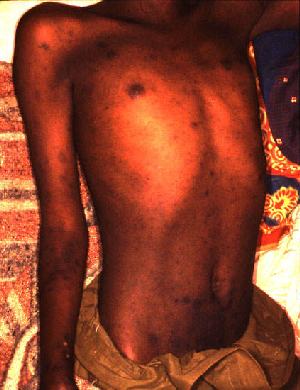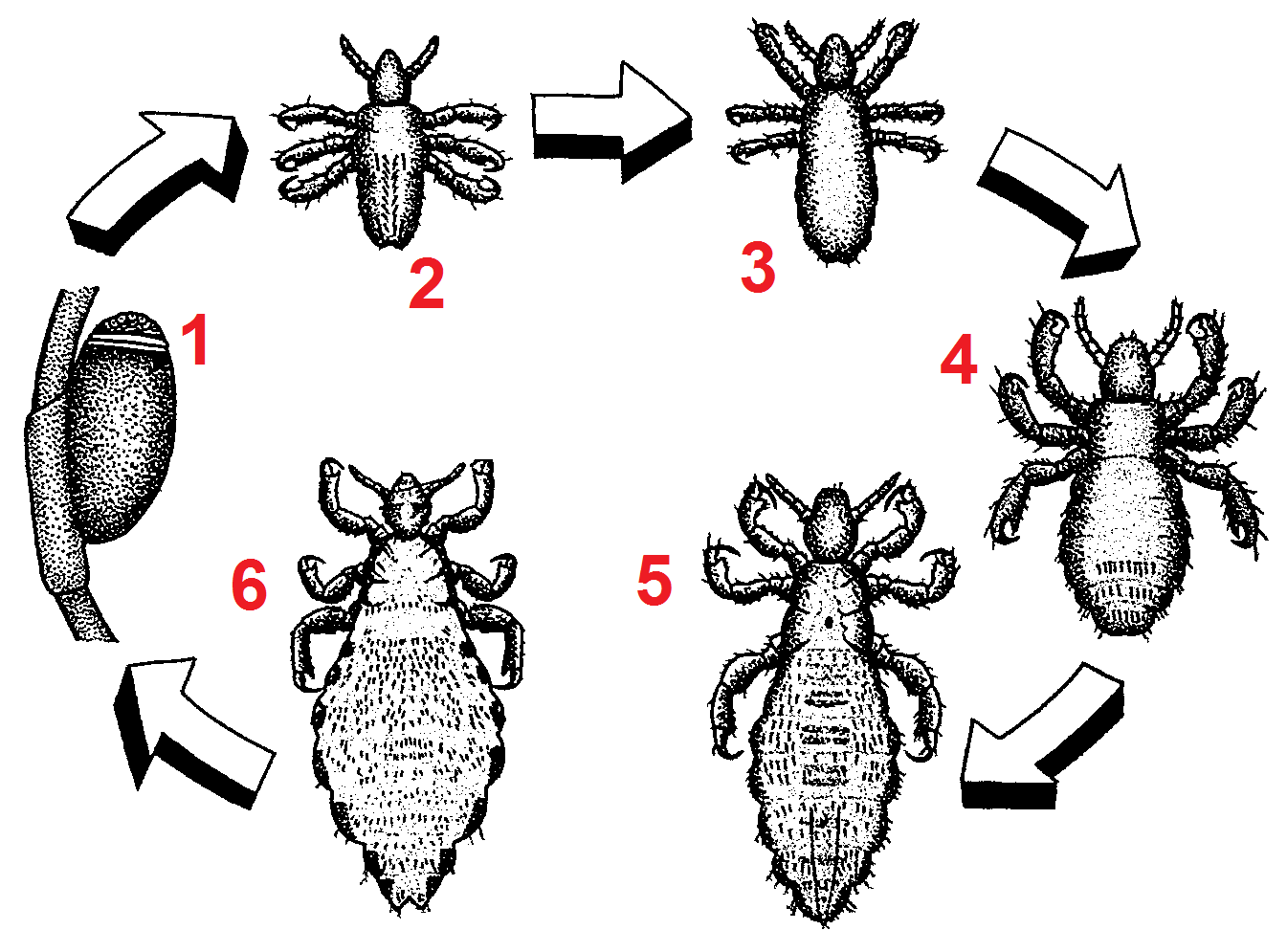|
Typhus
Typhus, also known as typhus fever, is a group of infectious diseases that include epidemic typhus, scrub typhus, and murine typhus. Common symptoms include fever, headache, and a rash. Typically these begin one to two weeks after exposure. The diseases are caused by specific types of bacterial infection. Epidemic typhus is caused by '' Rickettsia prowazekii'' spread by body lice, scrub typhus is caused by '' Orientia tsutsugamushi'' spread by chiggers, and murine typhus is caused by '' Rickettsia typhi'' spread by fleas. Vaccines have been developed, but none is commercially available. Prevention is achieved by reducing exposure to the organisms that spread the disease. Treatment is with the antibiotic doxycycline. Epidemic typhus generally occurs in outbreaks when poor sanitary conditions and crowding are present. While once common, it is now rare. Scrub typhus occurs in Southeast Asia, Japan, and northern Australia. Murine typhus occurs in tropical and subtropi ... [...More Info...] [...Related Items...] OR: [Wikipedia] [Google] [Baidu] [Amazon] |
Epidemic Typhus
Epidemic typhus, also known as louse-borne typhus, is a form of typhus so named because the disease often causes epidemics following wars and natural disasters where civil life is disrupted. Epidemic typhus is spread to people through contact with infected body lice, in contrast to endemic typhus which is usually transmitted by fleas. Though typhus has been responsible for millions of deaths throughout history, it is still considered a rare disease that occurs mainly in populations that suffer unhygienic extreme overcrowding. Typhus is most rare in industrialized countries. It occurs primarily in the colder, mountainous regions of central and east Africa, as well as Central and South America. The causative organism is '' Rickettsia prowazekii'', transmitted by the human body louse (''Pediculus humanus corporis''). Untreated typhus cases have a fatality rate of approximately 40%. Epidemic typhus should not be confused with murine typhus, which is more endemic to the United Sta ... [...More Info...] [...Related Items...] OR: [Wikipedia] [Google] [Baidu] [Amazon] |
Scrub Typhus
Scrub typhus or bush typhus is a form of typhus caused by the intracellular parasite '' Orientia tsutsugamushi'', a Gram-negative α-proteobacterium of family Rickettsiaceae first isolated and identified in 1930 in Japan.Pediatric Scrub Typhus accessdate: 16 October 2011 Although the disease is similar in presentation to other forms of , its is no longer included in '' |
Rickettsia Typhi
''Rickettsia typhi'' is a small, Aerobic organism, aerobic, obligate intracellular, rod shaped Gram-negative bacteria, gram negative bacterium. It belongs to the typhus group of the ''Rickettsia'' genus, along with Rickettsia prowazekii, ''R. prowazekii''. ''R. typhi'' has an uncertain history, as it may have long gone shadowed by epidemic typhus (''R. prowazekii''). This bacterium is recognized as a biocontainment level 2/3 organism. ''R. typhi'' is a flea-borne disease that is best known to be the causative agent for the disease murine typhus, which is an Endemic (epidemiology), endemic typhus in humans that is distributed worldwide. As with all rickettsial organisms, ''R. typhi'' is a zoonotic agent that causes the disease ''murine typhus'', displaying non-specific mild symptoms of fevers, headaches, pains and rashes. There are two cycles of ''R. typhi'' transmission from animal reservoirs containing ''R. typhi'' to humans: a classic rat-flea-rat cycle that is most well studied an ... [...More Info...] [...Related Items...] OR: [Wikipedia] [Google] [Baidu] [Amazon] |
Murine Typhus
Murine typhus, also known as endemic typhus or flea-borne typhus, is a form of typhus caused by ''Rickettsia typhi'' transmitted by fleas (''Xenopsylla cheopis''), usually on rats, in contrast to epidemic typhus which is usually transmitted by lice. Murine typhus is an under-recognized entity, as it is often confused with viral illnesses. Most people who are infected do not realize that they have been bitten by fleas. Historically the term "hunger-typhus" was used in accounts by British POWs in Germany at the end of World War I when they described conditions in Germany. Names Murine typhus is also commonly known as endemic or flea-borne typhus, other names include shop, urban, Mexican, and rat typhus. Signs and symptoms Symptoms occur after 6–14 days with common symptoms being pyrexia, dermatitis, prostration, delirium, and in severe cases comatose. Untreated patients may be bedridden for 2–3 months and some are unable to work. Transmission ''Rickettsia typhi'' is the causat ... [...More Info...] [...Related Items...] OR: [Wikipedia] [Google] [Baidu] [Amazon] |
Typhoid Fever
Typhoid fever, also known simply as typhoid, is a disease caused by '' Salmonella enterica'' serotype Typhi bacteria, also called ''Salmonella'' Typhi. Symptoms vary from mild to severe, and usually begin six to 30 days after exposure. Often there is a gradual onset of a high fever over several days. This is commonly accompanied by weakness, abdominal pain, constipation, headaches, and mild vomiting. Some people develop a skin rash with rose colored spots. In severe cases, people may experience confusion. Without treatment, symptoms may last weeks or months. Diarrhea may be severe, but is uncommon. Other people may carry it without being affected, but are still contagious. Typhoid fever is a type of enteric fever, along with paratyphoid fever. ''Salmonella enterica'' Typhi is believed to infect and replicate only within humans. Typhoid is caused by the bacterium ''Salmonella enterica'' subsp. ''enterica'' serovar Typhi growing in the intestines, Peyer's patches, mesen ... [...More Info...] [...Related Items...] OR: [Wikipedia] [Google] [Baidu] [Amazon] |
Doxycycline
Doxycycline is a Broad-spectrum antibiotic, broad-spectrum antibiotic of the Tetracycline antibiotics, tetracycline class used in the treatment of infections caused by bacteria and certain parasites. It is used to treat pneumonia, bacterial pneumonia, acne vulgaris, acne, chlamydia infections, Lyme disease, cholera, typhus, and syphilis. It is also used to prevent malaria. Doxycycline may be taken Oral administration, by mouth or by intravenous, injection into a vein. Common side effects include diarrhea, nausea, vomiting, abdominal pain, and an increased risk of sunburn. Use during pregnancy is not recommended. Like other agents of the tetracycline class, it either slows or kills bacteria by inhibiting protein production. It kills malaria by targeting a plastid organelle, the apicoplast. Doxycycline was patented in 1957 and came into commercial use in 1967. It is on the WHO Model List of Essential Medicines, World Health Organization's List of Essential Medicines. Doxycyc ... [...More Info...] [...Related Items...] OR: [Wikipedia] [Google] [Baidu] [Amazon] |
Rickettsia Prowazekii
''Rickettsia prowazekii'' is a species of gram-negative, obligate intracellular parasitic, aerobic bacilliform bacteria of class Alphaproteobacteria that is the etiologic agent of epidemic typhus, transmitted in the feces of lice. In North America, the main reservoir for ''R. prowazekii'' is the flying squirrel. ''R. prowazekii'' is often surrounded by a protein microcapsular layer and slime layer; the natural life cycle of the bacterium generally involves a vertebrate and an invertebrate host, usually an arthropod, typically the human body louse. A form of ''R. prowazekii'' that exists in the feces of arthropods remains stably infective for months. ''R. prowazekii'' also appears to be the closest semi-free-living relative of mitochondria, based on genome sequencing. History Discovery Henrique da Rocha Lima, a Brazilian doctor, discovered this bacterium in 1916. He named it after his colleague Stanislaus von Prowazek, who had died from typhus in 1915. Both Prowazek and Ro ... [...More Info...] [...Related Items...] OR: [Wikipedia] [Google] [Baidu] [Amazon] |
Orientia Tsutsugamushi
''Orientia'' is a genus of bacteria in family Rickettsiaceae. They are obligate intracellular, gram-negative Gram-negative bacteria are bacteria that, unlike gram-positive bacteria, do not retain the crystal violet stain used in the Gram staining method of bacterial differentiation. Their defining characteristic is that their cell envelope consists ... bacteria found in insects and mammals. They are spread through the bites or feces of infected insects. The genus comprises the species '' Orientia tsutsugamushi'' and ''Orientia chuto'', which both cause scrub typhus in humans. Candidatus Orientia chiloensis Orientia chiloensis is a possible new species of Orientia identified as such by a highly divergent type-specific antigen gene. In Chile scrub typhus is known to occur in the southern half of the country and in particular Chiloé Island and the fjords and channels of Patagonia. Between 2015 and 2020 there was a total of 40 known cases in Chile with much of t ... [...More Info...] [...Related Items...] OR: [Wikipedia] [Google] [Baidu] [Amazon] |
Body Lice
The body louse (''Pediculus humanus humanus'', also known as ''Pediculus humanus corporis'') or the cootie is a hematophagic ectoparasite louse that infests humans. It is one of three lice which infest humans, the other two being the head louse, and the crab louse or pubic louse. Body lice may lay eggs on the host's hairs and clothing, but clothing is where the majority of eggs are usually secured. Since body lice cannot jump or fly, they spread by direct contact with another person or more rarely by contact with clothing or bed sheets that are infested. Body lice are disease vectors and can transmit pathogens that cause human diseases such as epidemic typhus, trench fever, and relapsing fever. In developed countries, infestations are only a problem in areas of poverty where there is poor body hygiene, crowded living conditions, and a lack of access to clean clothing. Outbreaks can also occur in situations where large groups of people are forced to live in unsanitary cond ... [...More Info...] [...Related Items...] OR: [Wikipedia] [Google] [Baidu] [Amazon] |
Fleas
Flea, the common name for the order Siphonaptera, includes 2,500 species of small flightless insects that live as external parasites of mammals and birds. Fleas live by ingesting the blood of their hosts. Adult fleas grow to about long, are usually dark in color, and have bodies that are "flattened" sideways or narrow, enabling them to move through their hosts' fur or feathers. They lack wings; their hind legs are extremely well adapted for jumping. Their claws keep them from being dislodged, and their mouthparts are adapted for piercing skin and sucking blood. Some species can leap 50 times their body length, a feat second only to jumps made by another group of insects, the superfamily of froghoppers. Flea larvae are worm-like, with no limbs; they have chewing mouthparts and feed on organic debris left on their hosts' skin. Genetic evidence indicates that fleas are a specialised lineage of parasitic scorpionflies (Mecoptera) ''sensu lato'', most closely related to the fa ... [...More Info...] [...Related Items...] OR: [Wikipedia] [Google] [Baidu] [Amazon] |
Meningoencephalitis
Meningoencephalitis (; from ; ; and the medical suffix ''-itis'', "inflammation"), also known as herpes meningoencephalitis, is a medical condition that simultaneously resembles both meningitis, which is an infection or inflammation of the meninges, and encephalitis, which is an infection or inflammation of the brain tissue. Signs and symptoms Signs of meningoencephalitis include unusual behavior, personality changes, nausea, and thinking problems. Symptoms may include headache, fever, pain in neck movement, light sensitivity, and seizure. Causes The organisms which cause meningoencephalitis include bacterial pathogens, protozoans, and viruses. Bacterial Veterinarians have observed meningoencephalitis in animals infected with listeriosis, caused by the pathogenic bacteria '' L. monocytogenes''. Meningitis and encephalitis already present in the brain or spinal cord of an animal may form simultaneously into meningeoencephalitis. The bacteria commonly targets the sensiti ... [...More Info...] [...Related Items...] OR: [Wikipedia] [Google] [Baidu] [Amazon] |






